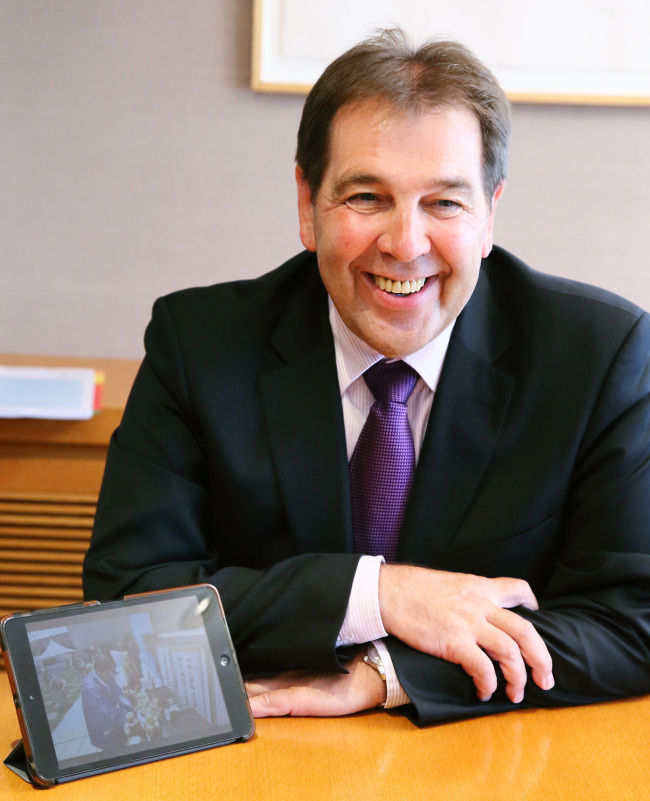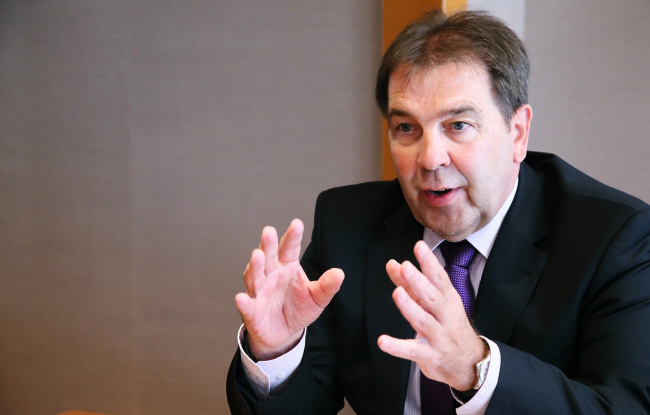[Herald Interview] ‘Decisiveness key to keeping ahead of competition’
Merck seeks close ties with Korean partners
By 김영원Published : Sept. 2, 2015 - 16:50
Merck, the world’s leading chemical and electronics materials firm, has constantly explored untouched business areas for more than three centuries, including the firm’s three main business pillars -- performance materials, health care and life science -- and has been able to stay on top in each field.
Walter Galinat, president and CEO of the German company’s performance materials business, said placing an emphasis on making bold business decisions is a key to securing the lead in competition and driving innovation.
Walter Galinat, president and CEO of the German company’s performance materials business, said placing an emphasis on making bold business decisions is a key to securing the lead in competition and driving innovation.

“Merck is very much aware of the fact that we can remain successful only when we come up with new products,” said the Merck president in a recent interview with The Korea Herald, adding that businesses should make decisive actions in order to get ahead of other competitors.
In order to have a competitive edge over rivals, the company which was founded in 1668 spends around 9 percent of its sales in R&D for performance materials, higher than the industry’s average at 2 to 3 percent, according to the German firm.
Merck’s performance materials business encompasses a wide range of specialty chemicals used, for example, in displays, cosmetics and semiconductors.
One of the company’s next growth engines is the organic light-emitting diode business. The OLED display is often regarded as a futuristic display as it can be made into flexible and bendable products and has more vibrant colors than the widely-used liquid crystal display. However, most global display makers are hesitant to throw their hat into the ring due in large part to manufacturing challenges.
Currently, an evaporation process which condenses the vapors of molecular organic materials on the surface of glass or plastic panels in vacuum chambers is widely used to roll out the large-size OLED, but its manufacturing yields are said to be far from satisfactory.
The Merck executive said other display makers, including Samsung Display, would join LG Display in producing large-size OLED displays for products like TVs, should the LG Group affiliate successfully churn out the OLED displays with a new printing technology for OLED, which leverages the conventional consumer ink-jet printer tech.

The ink-jet printing for OLED is more cost effective and apt for the mass production of large OLED screens.
LG Display, a pioneer in the world’s OLED display industry, is collaborating with Merck to commercialize printable OLED displays.
The Korean display manufacturer has committed itself to growing the OLED industry for several years and decided earlier this month to further invest 10 trillion won ($8.32 billion) for its OLED display business.
Merck is also working with its partner Seiko Epson to utilize the ink-jet printing technology for OLED displays.
Researchers at Merck's two OLED R&D centers in Korea -- the OLED Application Development Laboratory and the OLED Application Center in Pyeongtaek, Gyeonggi Province -- are working flat out for the commercialization of the printable OLED displays and development of new display technology.
“The R&D centers in Korea is in line with the firm’s management philosophy that we must be close to our customers.” he said.
When asked about collaboration with local firms here, he said Merck was pinning high hopes on photovoltaic power generation business, which is very promising and would incite changes in people’s daily life.
Merck’s flexible, hexagonal photovoltaic panels will be able to be utilized in various fields, such as tree-like solar lampposts -- which adopt a less-intrusive design and are more efficient than the current street lamps -- wearable jackets and a backpack for charging electronics devices.
By Kim Young-won(wone0102@heraldcorp.com)







![[KH Explains] How should Korea adjust its trade defenses against Chinese EVs?](http://res.heraldm.com/phpwas/restmb_idxmake.php?idx=644&simg=/content/image/2024/04/15/20240415050562_0.jpg&u=20240415144419)










![[Today’s K-pop] Stray Kids to return soon: report](http://res.heraldm.com/phpwas/restmb_idxmake.php?idx=642&simg=/content/image/2024/04/16/20240416050713_0.jpg&u=)